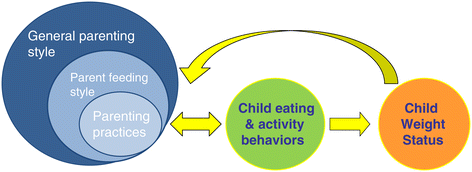Development of the General Parenting Observational Scale to assess parenting during family meals
- PMID: 25888976
- PMCID: PMC4395900
- DOI: 10.1186/s12966-015-0207-3
Development of the General Parenting Observational Scale to assess parenting during family meals
Abstract
Background: There is growing interest in the relationship between general parenting and childhood obesity. However, assessing general parenting via surveys can be difficult due to issues with self-report and differences in the underlying constructs being measured. As a result, different aspects of parenting have been associated with obesity risk. We developed a more objective tool to assess general parenting by using observational methods during a mealtime interaction.
Methods: The General Parenting Observational Scale (GPOS) was based on prior work of Baumrind, Maccoby and Martin, Barber, and Slater and Power. Ten dimensions of parenting were included; 4 were classified in the emotional dimension of parenting (warmth and affection, support and sensitivity, negative affect, detachment), and 6 were classified in the behavioral dimension of parenting (firm discipline and structure, demands for maturity, psychological control, physical control, permissiveness, neglect). Overweight children age 8-12 years old and their parent (n = 44 dyads) entering a weight control program were videotaped eating a family meal. Parents were coded for their general parenting behaviors. The Mealtime Family Interaction Coding System (MICS) and several self-report measures of general parenting were also used to assess the parent-child interaction. Spearman's correlations were used to assess correlation between measures.
Results: The emotional dimensions of warmth/affection and support/sensitivity, and the behavioral dimension of firm discipline/structure were robustly captured during the family meals. Warmth/affection and support/sensitivity were significantly correlated with affect management, interpersonal involvement, and communication from the MICS. Firm discipline/structure was inversely correlated with affect management, behavior control, and task accomplishment. Parents who were older, with higher educational status, and lower BMIs were more likely to display warmth/affection and support/sensitivity.
Conclusion: Several general parenting dimensions from the GPOS were highly correlated with similar family functioning constructs from the MICS. This new observational tool appears to be a valid means of assessing general parenting behaviors during mealtimes and adds to our ability to measure parent-level factors affecting child weight-related outcomes. Future evaluation of this tool in a broader range of the population and other family settings should be conducted.
Figures

Similar articles
-
Warm Parenting Associated with Decreasing or Stable Child BMI during Treatment.Child Obes. 2016 Apr;12(2):94-102. doi: 10.1089/chi.2015.0127. Epub 2016 Feb 19. Child Obes. 2016. PMID: 26895374 Free PMC article.
-
Mutually Responsive Orientation: A novel observational assessment of mother-child mealtime interactions.Appetite. 2016 Oct 1;105:400-9. doi: 10.1016/j.appet.2016.06.019. Epub 2016 Jun 15. Appetite. 2016. PMID: 27317618
-
[Early restrictive feeding disorders: Quantitative assessment of parent/infant feeding interactions].Encephale. 2018 Feb;44(1):32-39. doi: 10.1016/j.encep.2016.08.009. Epub 2016 Oct 11. Encephale. 2018. PMID: 27742391 French.
-
Parenting styles, feeding styles, and their influence on child obesogenic behaviors and body weight. A review.Appetite. 2013 Dec;71:232-41. doi: 10.1016/j.appet.2013.08.015. Epub 2013 Aug 31. Appetite. 2013. PMID: 24001395 Review.
-
The relations between parents' Big Five personality factors and parenting: a meta-analytic review.J Pers Soc Psychol. 2009 Aug;97(2):351-62. doi: 10.1037/a0015823. J Pers Soc Psychol. 2009. PMID: 19634980 Review.
Cited by
-
Black Children's Perceptions of Parental Support and Parenting Practices: 6-Month Weight Loss and Retention in a Pediatric Weight Management Program.Obes Sci Pract. 2025 Jan 17;11(1):e70042. doi: 10.1002/osp4.70042. eCollection 2025 Feb. Obes Sci Pract. 2025. PMID: 39830712 Free PMC article.
-
Does Parenting Style Affect Adolescent IBD Transition Readiness and Self-Efficacy Scores?Children (Basel). 2021 May 4;8(5):367. doi: 10.3390/children8050367. Children (Basel). 2021. PMID: 34064470 Free PMC article.
-
Dyadic parent-college student digital interaction styles.J Fam Psychol. 2023 Sep;37(6):864-874. doi: 10.1037/fam0001117. Epub 2023 Jun 15. J Fam Psychol. 2023. PMID: 37326557 Free PMC article.
-
Warm Parenting Associated with Decreasing or Stable Child BMI during Treatment.Child Obes. 2016 Apr;12(2):94-102. doi: 10.1089/chi.2015.0127. Epub 2016 Feb 19. Child Obes. 2016. PMID: 26895374 Free PMC article.
-
Observational Tools Using Video Recordings of Parent-Child Feeding Interactions: A Narrative Review.Children (Basel). 2022 Dec 8;9(12):1924. doi: 10.3390/children9121924. Children (Basel). 2022. PMID: 36553367 Free PMC article. Review.
References
-
- Faith MS, Van Horn L, Appel LJ, Burke LE, Carson JA, Franch HA, et al. Evaluating parents and adult caregivers as “agents of change” for treating obese children: evidence for parent behavior change strategies and research gaps: a scientific statement from the American Heart Association. Circulation. 2012;125(9):1186–207. doi: 10.1161/CIR.0b013e31824607ee. - DOI - PubMed
Publication types
MeSH terms
Grants and funding
LinkOut - more resources
Full Text Sources
Other Literature Sources
Medical
Research Materials

